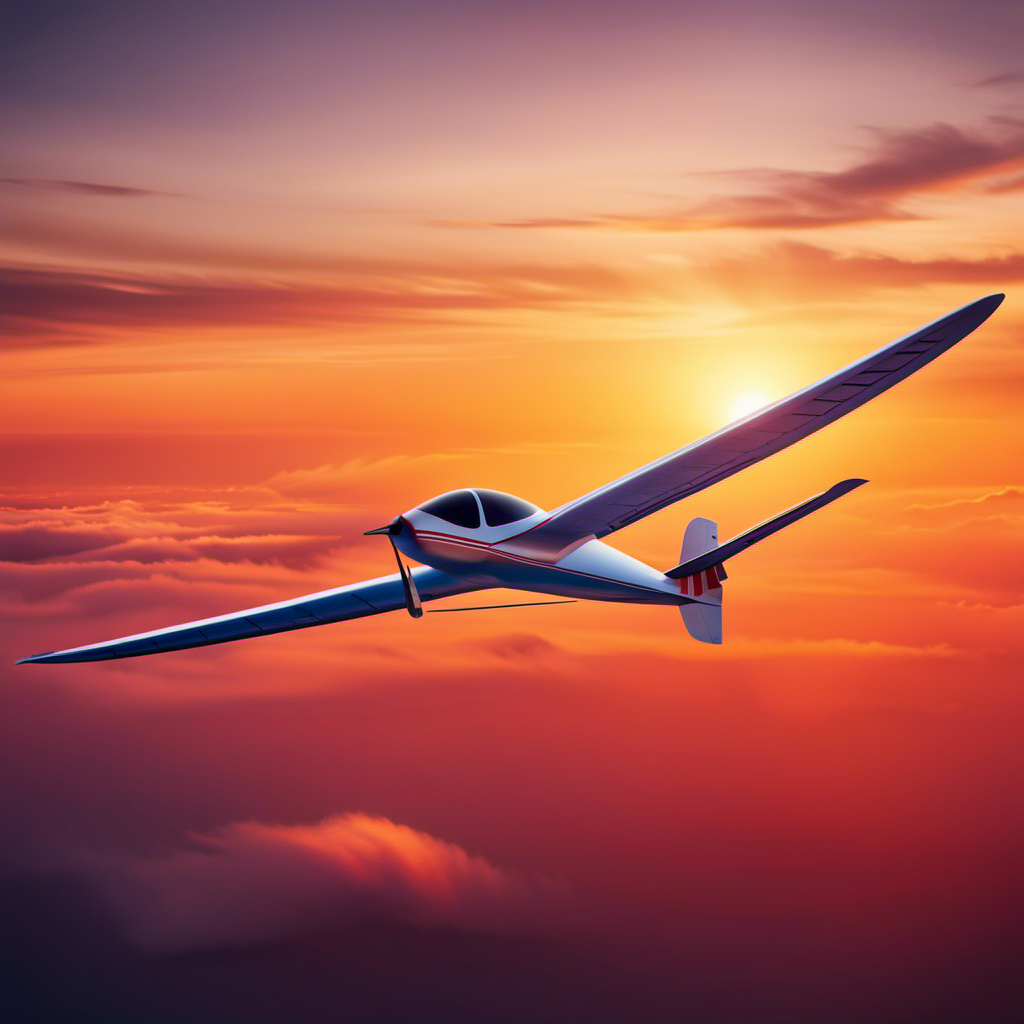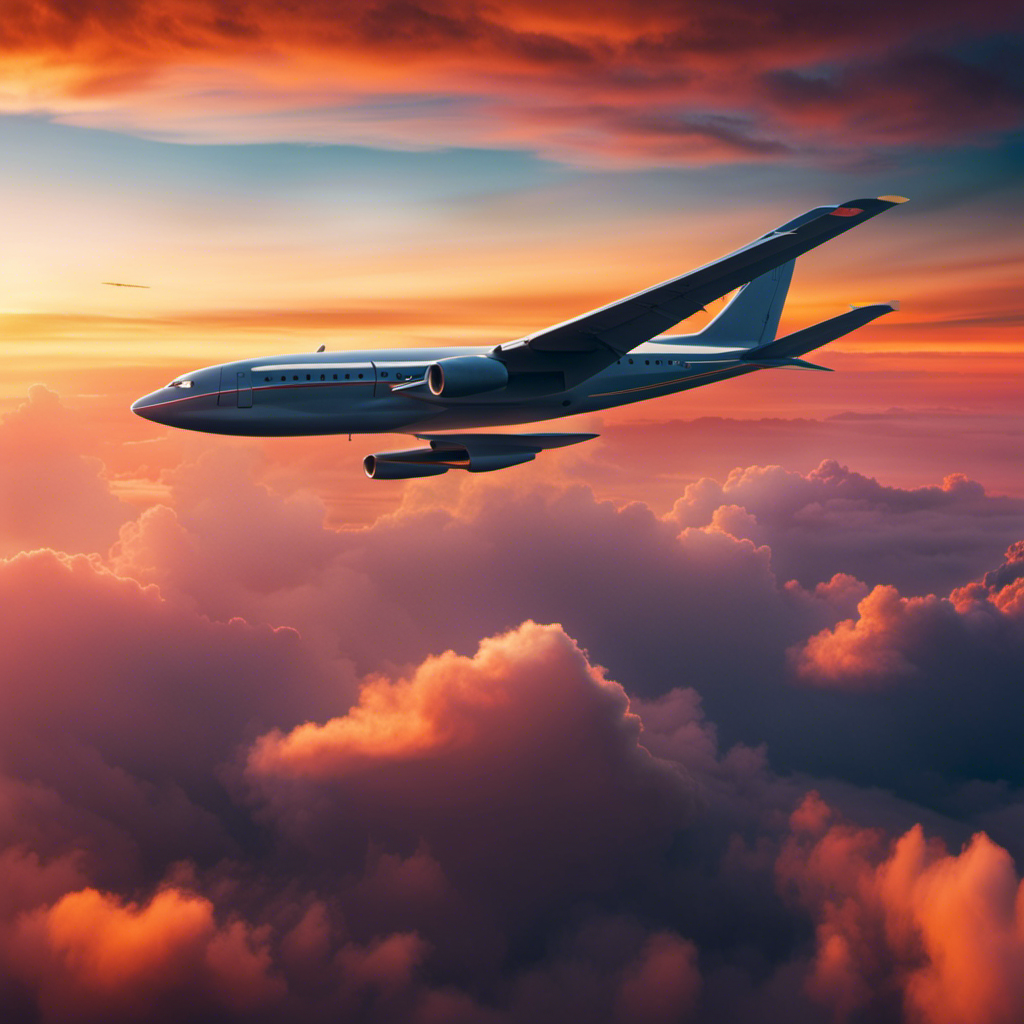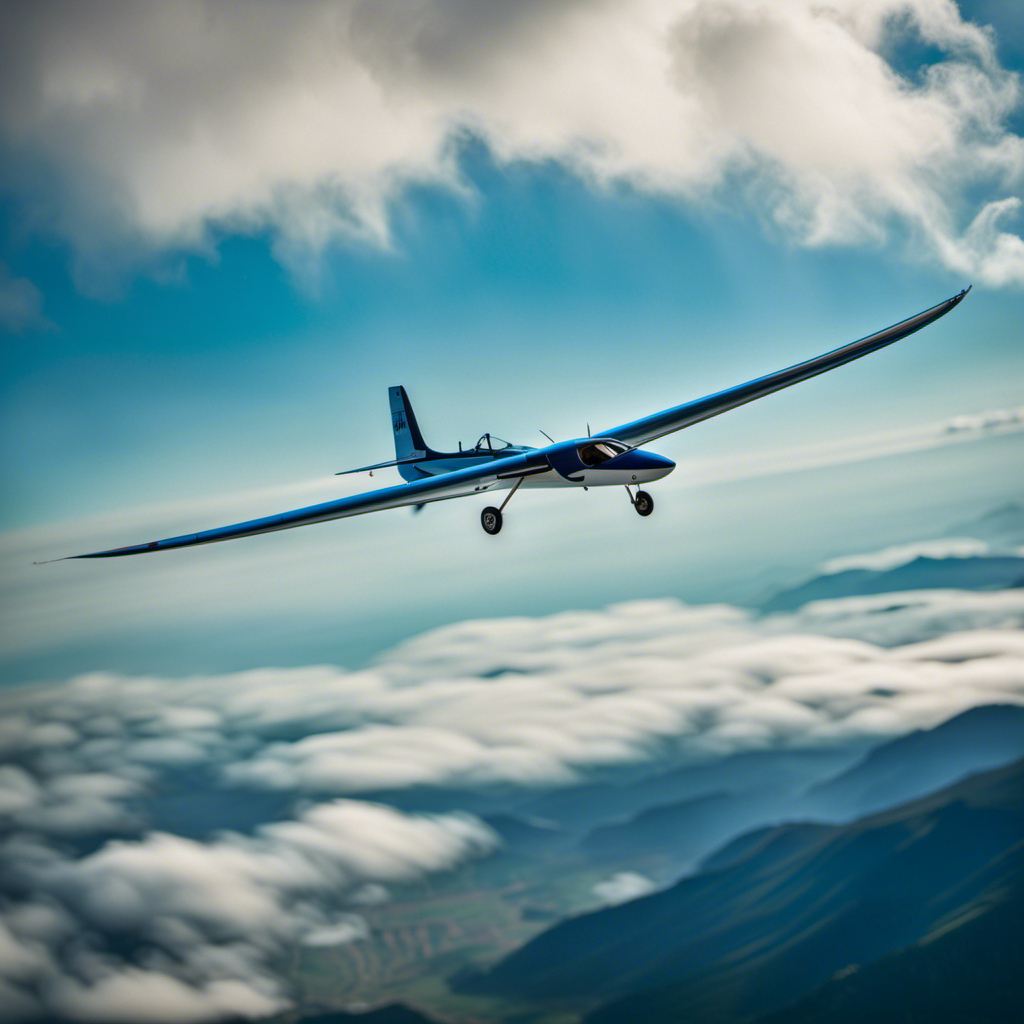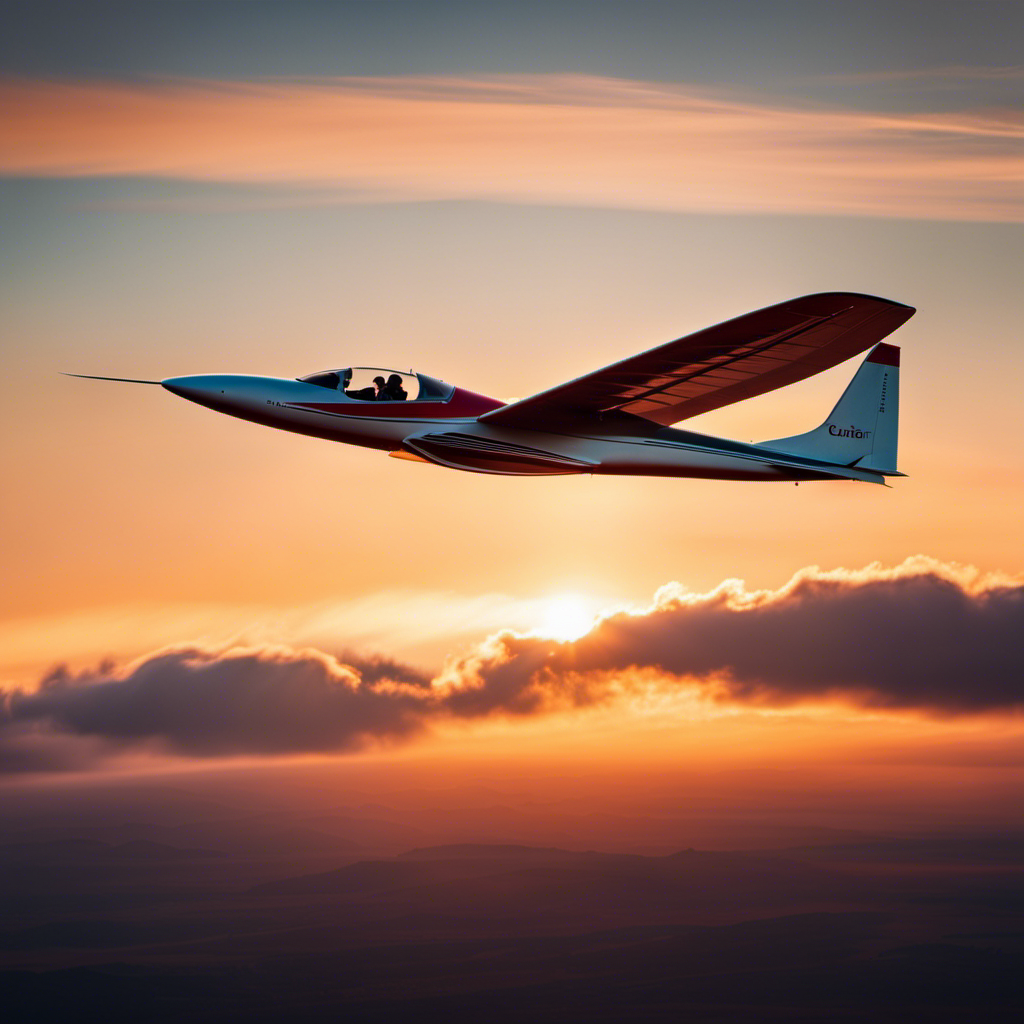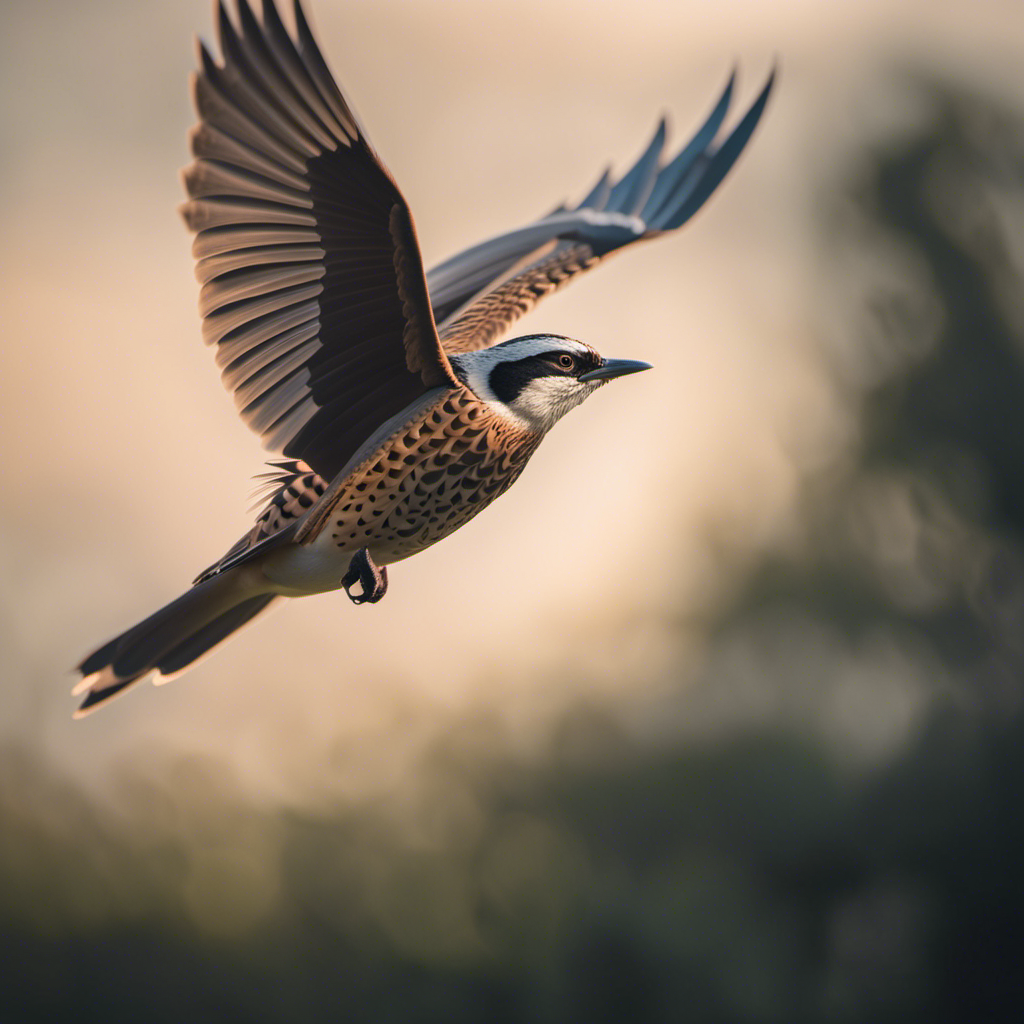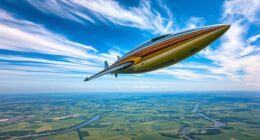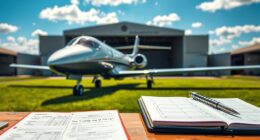As a glider pilot, I am continually astounded by the way these sleek aircraft seem to defy gravity and stay airborne for extended periods of time. Gliders have a remarkable ability to soar through the sky for hours, resembling graceful birds effortlessly riding invisible air currents.
In this article, we will delve into the intricacies of glider flight, exploring the factors that contribute to their impressive endurance. From atmospheric currents to design innovations, we will unravel the secrets behind how long gliders can truly stay airborne.
Key Takeaways
- Technological advancements in glider flight have led to longer flight durations and increased efficiency.
- Sustainability innovations in glider flight focus on reducing energy consumption and minimizing environmental impact, including carbon emissions.
- Safety considerations for long flights include thorough pre-flight checks, well-rehearsed emergency procedures, and careful assessment of weather conditions.
- Glider flight competitions, such as the World Gliding Championships, test the navigational skills and extended flight abilities of skilled pilots, showcasing the capabilities and endurance of gliders.
The Basics of Glider Flight
So, you’re probably wondering how long gliders can stay in the air.
Glider aerodynamics play a crucial role in sustaining flight without an engine. Gliders are designed with sleek and efficient shapes to minimize drag and maximize lift. This allows them to stay airborne for extended periods.
One of the key factors that enable gliders to stay aloft is the presence of thermals and updrafts in the atmosphere. Thermals are columns of warm air that rise from the ground due to heating by the sun. Glider pilots can take advantage of these thermals by circling within them, gaining altitude and extending their flight time.
Updrafts, on the other hand, are created by various atmospheric conditions such as wind blowing over hills or mountains. By understanding and utilizing these atmospheric currents, gliders can stay airborne for hours, even without an engine.
Understanding Atmospheric Currents
Understanding atmospheric currents helps determine the duration of glider flights. Atmospheric currents refer to the movement of air in the Earth’s atmosphere, which can have a significant impact on glider efficiency. By studying these currents, glider pilots can identify areas of rising air, known as thermals, which can provide the necessary lift for sustained flight.
Thermals are created by uneven heating of the Earth’s surface, and gliders can ride these currents to gain altitude and extend their flight time. Additionally, knowledge of atmospheric currents allows pilots to plan their flights more effectively, taking advantage of prevailing winds and avoiding areas of sinking air. By understanding and utilizing these currents, glider pilots can optimize their flight duration and make the most of their time in the air.
This understanding of atmospheric currents leads us to the next aspect of glider performance: the role of design.
The Role of Design in Glider Performance
To optimize your glider’s performance, consider how its design affects its flight capabilities. Design innovation plays a crucial role in enhancing glider performance and achieving maximum aerodynamic efficiency.
By incorporating cutting-edge design concepts and materials, gliders can minimize drag and maximize lift, allowing for longer and more efficient flights. The shape of the wings, fuselage, and tail all contribute to the glider’s ability to generate lift and maintain stability in the air. Design features such as winglets and airfoils further enhance aerodynamic efficiency by reducing turbulence and increasing lift-to-drag ratios.
These design considerations enable gliders to stay in the air for extended periods, taking advantage of rising air currents and thermal updrafts. Understanding how design impacts glider performance is essential for harnessing the full potential of these remarkable aircraft.
Now, let’s explore the meteorological factors that impact glider flight.
Meteorological Factors that Impact Glider Flight
When planning your glider flight, it’s important to consider the meteorological factors that will impact your journey. Meteorological forecasting plays a crucial role in determining the optimal conditions for extended flight. Here are three key factors to consider:
-
Thermals: These are rising columns of warm air that can provide significant lift for gliders. By understanding the formation and movement of thermals, pilots can strategically navigate their flight path to maximize lift and extend their time in the air.
-
Ridge Lift: When wind encounters a ridge or mountain, it is forced to rise, creating a lift known as ridge lift. This phenomenon can be a valuable source of sustained lift for gliders, allowing them to stay airborne for extended periods.
-
Weather Patterns: Studying weather patterns, such as fronts and pressure systems, can provide valuable insights into the atmospheric conditions that favor long-duration glider flights. By analyzing these patterns, pilots can make informed decisions about when and where to fly.
Considering these meteorological factors is essential for planning successful and extended glider flights. By harnessing the power of thermals and ridge lift, and leveraging weather forecasting, pilots can enhance their skills and techniques for extended flight.
Pilot Skills and Techniques for Extended Flight
Pilots can enhance their skills and techniques for extended flight by effectively harnessing the power of thermals and ridge lift. By employing various pilot techniques and soaring methods, glider pilots can maximize their time aloft and achieve impressive endurance.
One key technique is the ability to identify and exploit thermals, which are columns of rising air created by the sun’s heating of the Earth’s surface. By circling within a thermal, pilots can gain altitude and stay airborne for longer periods.
Additionally, ridge lift is a technique that involves flying along the slope of a hill or mountain to catch the updraft created by the wind hitting the terrain. By skillfully using these techniques, pilots can extend their flight times and push the boundaries of glider endurance.
Transitioning into the subsequent section about records and achievements in glider endurance, these pilot techniques and soaring methods have enabled glider pilots to achieve remarkable feats of endurance in the sky.
Records and Achievements in Glider Endurance
Using these techniques, glider pilots have achieved impressive feats of endurance in the sky, pushing the boundaries of what is possible. Glider endurance challenges and competitions have spurred pilots to test their limits and strive for longer and longer flights.
In these competitions, pilots aim to stay aloft for as long as possible, utilizing thermal lift and ridge lift to gain altitude and extend their flight time. The record for the longest glider flight currently stands at an astounding 1,502 kilometers, completed in 2003. This achievement showcases the remarkable endurance and skill of glider pilots.
It is worth noting that such long flights require meticulous planning, precise navigation, and a deep understanding of meteorological conditions.
Transitioning into the subsequent section about technology advancements in glider design, these records and achievements have also driven the development of more efficient gliders that can sustain flights for extended durations.
Technology Advancements in Glider Design
Advancements in glider design have led to the creation of more efficient aircraft that can sustain flights for extended durations. These innovations in sustainability and aerodynamics have revolutionized the way gliders operate, allowing them to stay in the air for longer periods of time.
Sustainability innovations such as lightweight materials and improved energy management systems have significantly reduced the gliders’ energy consumption, enabling them to stay aloft for hours on end. Additionally, aerodynamic advancements, such as optimized wing shapes and reduced drag, have increased the gliders’ efficiency, allowing them to glide through the air with minimal energy loss.
These technological advancements have opened up new possibilities for long-duration flights in gliders, pushing the boundaries of what was previously thought possible. However, with extended flights comes the need for careful consideration of safety measures to ensure the well-being of the pilots and the success of the mission.
Safety Considerations for Long Flights
When embarking on extended flights, it’s crucial to prioritize safety measures to ensure a successful and secure journey. Safety considerations are of utmost importance during long glider flights, as they are often conducted in remote areas and without the assistance of a motor.
Before takeoff, thorough pre-flight checks should be performed, including inspecting the aircraft for any signs of damage or malfunction. Emergency procedures should be well-rehearsed and understood by all crew members, including actions to take in the event of an engine failure or loss of control. It is also important to consider weather conditions and plan the flight accordingly, avoiding areas of potential turbulence or severe weather.
By adhering to these safety considerations and being prepared for emergencies, glider pilots can ensure a safe and successful journey.
Transitioning to the subsequent section, famous glider flights and expeditions have showcased the remarkable capabilities and endurance of these aircraft.
Famous Glider Flights and Expeditions
Famous glider flights and expeditions have showcased the remarkable capabilities and endurance of these aircraft, as pilots have successfully completed long journeys across vast distances.
Throughout history, there have been renowned glider pilots who have pushed the boundaries of what these aircraft can achieve. One such example is Steve Fossett, who in 2006 set the world record for the longest glider flight, covering a distance of over 2,900 kilometers.
Glider flight competitions, such as the World Gliding Championships, also attract skilled pilots from around the world to compete in various tasks that test their navigational skills and ability to stay aloft for extended periods.
These feats demonstrate the incredible potential of gliders and the skill of their pilots.
Looking ahead, the future of glider flight and sustainable aviation holds even more exciting possibilities.
The Future of Glider Flight and Sustainable Aviation
You can expect exciting developments in the future of glider flight and sustainable aviation. As technology advances, so does the potential for innovative and environmentally friendly solutions in aviation. The glider industry is actively working towards creating more efficient and sustainable aircraft that have minimal environmental impact. Future innovations in glider flight include the use of electric propulsion systems, advanced materials for lighter and stronger gliders, and improved aerodynamics for increased efficiency and performance. These advancements not only contribute to reducing carbon emissions, but also offer longer flight durations and enhanced safety. In the table below, I have summarized some of the key future innovations and their potential environmental impact:
| Future Innovations | Environmental Impact |
|---|---|
| Electric propulsion | Reduced carbon emissions, quieter flights |
| Advanced materials | Lighter gliders, reduced fuel consumption |
| Improved aerodynamics | Increased efficiency, longer flight durations |
With these developments, the future of glider flight looks promising, with a focus on sustainability and minimizing environmental impact.
Frequently Asked Questions
What is the maximum altitude a glider can reach?
The maximum altitude a glider can reach depends on various factors, including its design, weight, and glider performance. Achieving high altitudes requires optimal glider performance and efficient use of thermals and updrafts.
Are there any restrictions on how far a glider can travel?
There are no restrictions on the flight range of a glider, allowing for cross country flights. Gliders can travel long distances as they rely on thermals and other lift sources to stay airborne.
How does the weight of the glider impact its endurance in flight?
The weight of a glider directly affects its endurance in flight. A lighter glider design allows for longer flight times, while heavier gliders may struggle to stay aloft. Wind conditions also play a role in glider endurance.
Can gliders fly at night or in adverse weather conditions?
Gliders can fly at night and in adverse weather conditions by utilizing advanced flying techniques and adhering to strict safety measures. These include using instruments for navigation and weather monitoring, and following specific procedures for flying in low visibility and strong winds.
Are there any regulations or guidelines for glider pilots regarding rest periods during long flights?
Rest period regulations for glider pilots are crucial to prevent pilot fatigue. It is essential for pilots to have adequate rest during long flights to ensure their alertness and safety.
Conclusion
In conclusion, glider flight is an exhilarating and challenging endeavor that requires a deep understanding of atmospheric currents, design principles, and meteorological factors. With the right pilot skills and techniques, as well as advancements in glider design technology, extended flights are becoming increasingly achievable.
However, it is important to always prioritize safety and consider the risks associated with long flights.
As we look towards the future, how can we continue to push the boundaries of glider flight while also ensuring sustainable aviation practices?
Orion, better known as “Jetstream,” is the voice that brings the stories of the skies to life. His fascination with aviation began at a young age, sparked by his father’s tales of flying and adventure. Orion’s journey into the world of gliding was serendipitous, and from the moment he took his first glider flight, he knew he had found his calling.
